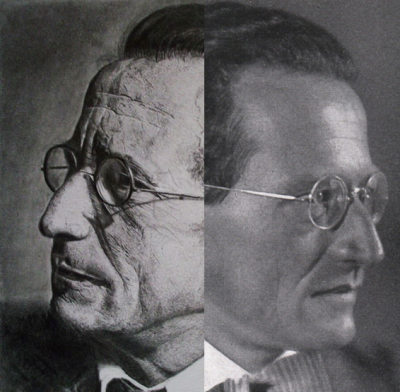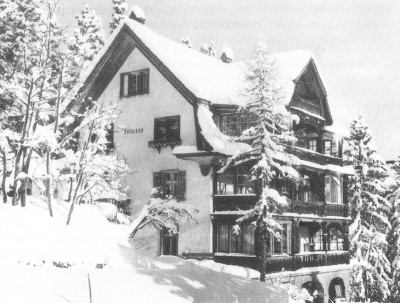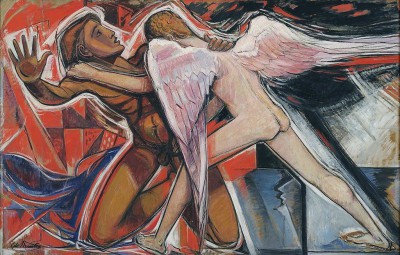
Schrödinger looked into the future and the past at the same time, just like Janus. He opened the door to modern physics, and then tried to close it. He wanted to return to the secure world of classical physics at the same time as he dismissed as childishly naïve the materialistic world view at its core.
The story about Erwin Schrödinger is often told as follows. He discovered the Schrödinger equation and became one of the founding fathers of quantum mechanics. But then he came to dislike his own creation intensely. “I don’t like it, and I’m sorry I ever had anything to do with it”, he said about the standard probabilistic interpretation of his own equation. To emphasize the absurdity of the implications of quantum mechanics he came up with the Schrödinger’s cat thought experiment, which has become part of the wider culture of the modern world.
I was therefore surprised and confused when I started reading Schrödinger’s essay My View of the World, the first part of which he wrote in the autumn of 1925, just a couple of months before he formulated the Schrödinger equation. Schrödinger describes his philosophical journey from Schopenhauer to the Vedantic ideas of ancient India. He presents convincing arguments why it makes no sense to talk about a world of objects without any observers. All objects are objects of perception, he argues, and you cannot separate the perceiving subject from the perceived object like Descartes tried to do with his dualistic notions of res cogitans and res extensa.
It seemed to me that such a view would make it quite easy to accept the implications of quantum mechanics, as they are usually presented: if it is impossible by assumption to observe an object (Schrödinger’s cat), it makes no physical sense to ascribe any definite properties to it (such as being alive or dead).
How come, then, that Schrödinger didn’t accept quantum mechanics – and more than that, was deeply upset about it? To find out, I read more about his life and work. I got some clues, but I cannot say that I have resolved the paradox. Here I collect pieces of the puzzle, and express some meandering thoughts about how they may fit together.
The development of Schrödinger’s philosophy
Towards the end of his life, Schrödinger wrote in the foreword to My View of the World that as a young man he looked forward to the chair of theoretical physics in Czernowitz, which he expected to be offered in 1918. There he could do a decent job as a lecturer, and devote himself to philosophy. However, history intervened, the Dual Monarchy split, and Czernowitz became part of Romania.
Schrödinger’s interest in philosophy went back at least to the time as a student in Vienna. Together with his best friend, the botany student Franz Frimmel, he used to discuss philosophical questions during long evening walks about the city, which sometimes lasted till the early hours of the morning.
Schrödinger’s first major philosophical influence was a book by Richard Semon from 1904 called The Mneme as Conservative Principle, which put forward the curious hypothesis of psycho-lamarckism. According to this theory, memories can be inherited. Schrödinger and Frimmel read this book together and discussed it in detail. Their shared youthful enthusiasm may well have been the starting point for Schrödinger’s life-long interest in the origin and nature of life. This interest led to the famous book What is life? from 1944, which inspired Watson and Crick in their search for the DNA molecule.
At the end of World War I Schrödinger’s philosophical studies intensified. He read every word of Schopenhauer, whose dark but systematic outlook may have created some coherence for the searching mind to the shattered society and painful experiences of the time. Schopenhauer led Schrödinger to Indian philosophy. He came to believe in Vedanta, a belief that lasted for the rest of his life. From now on, his philosophical views remained remarkably fixed.
Maybe the memories of the war created a deep need for the more harmonious realm beyond the personal and wordly that Vedantic philosophy offered. The deaths of Erwin’s father in 1919 and mother in 1921 may have contributed to this need.

Arthur Schopenhauer
Schrödinger’s views of the world
Such feelings and motivations are absent from his philosophical manifesto My view of the world. It is abstract yet personal. Its temporal proximity to his breakthrough in quantum mechanics suggests that it was written in the same surge of energy during the second half of 1925.
Nevertheless, he never publicly associated his philosophy with his physics, as far as I know. Later in life he emphasized that they had little to do with each other. My view of the world was not published until 1961. Schrödinger wrote in the foreword:
“Not a word is said here of acausality, wave mechanics, indeterminacy relations, complementarity, an expanding universe, continuous creation, etc. Why doesn’t he talk about what he knows instead of trespassing on the professional philosopher’s preserves? Ne sutor supra crepidam. On this I can cheerfully justify myself: because I do not think that these things have as much connection as is currently supposed with a philosophical view of the world.”
As a bystander interested in the same fundamental questions as Schrödinger was, it is hard to understand this position. It suggests a strange dissociation between two aspects of his intellect, between the two roads towards understanding that he followed with passion, two roads that ought to lead to the same destination. To me, a central passage in My view of the world that has bearing on exactly those questions about the nature of the physical world that quantum mechanics forces us to ask is the following:
“Kant having established that the “tree in itself” is not only (as the English philosophers knew already) colourless, odourless, tasteless, and so on, but also belongs entirely to the realm of things-in-themselves which must in absolutely every respect remain inaccessible to our experience, we are in a position to declare once and for all that this thing-in-itself holds no interest for us whatever; that we are going, if necessary, to disregard it. Now, in the realm of things which do interest us, the tree presents itself just once, and we can just as well call this single datum a tree as a perception-of-a-tree – the first having the advantage of brevity. This one tree, then, is the one datum we have: it is at one and the same time the tree of physics and the tree of psychology. As we observed at an earlier point, the same elements go to make up both the Self and the external world, and in various complex forms are sometimes described as constituents of the external world – things – and sometimes as constituents of the Self – sensations, perceptions. These thinkers call this the restoration of the natural concept of the world, or the vindication of naïve realism. It does away with a whole mass of pseudo-problems, in particular the famous ignorabimus of Du Bois Reymond, of how feeling and consciousness could arise from a movement of atoms.”
This quote pinpoints from a philosophical perspective the essential lesson of quantum mechanics: that it is empirically meaningless to talk about things-in-themselves, and that they should therefore not be introduced into physical models. If one tries to do it, the model ends up erroneous; it disagrees with the empirical evidence.
At the end of the quote Schrödinger refers to one of the insoluble world-riddles that the physiologist Emil du Bois-Reymond presented before the Prussian Academy of Sciences in 1880, namely the origin of simple sensations. Du Bois-Reymond characterised this riddle as ignoramus et ignorabimus (we do not know and will not know).This ignorabimus is now rebranded as the hard problem of consciousness.
(As a side note, David Hilbert famously shot back fifty years later with militant optimism before the Society of German Scientists and Physicians in Königsberg: “In opposition to the foolish ‘ignorabimus’ our slogan shall be: We must know – we will know.” This sounds even better in German: “Wir müssen wissen — wir werden wissen.”)
It should be stressed that the naive realism of Schrödinger is rather the opposite of what may be referred to as naive scientific realism – the idea that the world is no more and no less than a collection of small objects that dance about in space, independently of any aware observers.
Instead, the naive realism of Schrödinger, or his natural concept of the world, is a world view in which existence and experience go hand in hand, where the aware observer is indispensable. All of this seemingly fits like a glove on the hand of the Copenhagen interpretation of quantum mechanics. How come, then, that Schrödinger disliked that approach to quantum mechanics deeply?
After some reflection I concluded that one philosophical reason may be the little weight Schrödinger assigned to the individual, in so doing following a long tradition in eastern philosophy. In contrast, in our attempts to come to terms with quantum mechanics from the Copenhagen angle, we often introduce as a crucial element individual observers who interact with their environment.
The inability in practice of a single observer to gain simultaneous knowledge about everything around her is transcended in the Copenhagen interpretation of quantum mechanics to the statement that there is no such complete knowledge to be gained even in principle. This fact is encoded in the physical formalism as superpositions of different possibilities that cannot be excluded given the actual incomplete knowledge.
The Heisenberg uncertainty relations can be seen from the Copenhagen perspective as a reflection of this predicament: the individual who interacts with her environment to learn something new inevitably perturbs the same environment so that she loses knowledge about something else. She is like the elephant in the glass shop: when she enters the shop to take a closer look at a beautiful vase at the back, she cannot help breaking a lot of other items, forever losing the possibility to learn anything about them.
In short, the intuitive understanding of quantum mechanics from the Copenhagen perspective relies on the individuality of the observers and the sharp distinction between the observer and the environment. Schrödinger, on the other hand, considered this individuality and this distinction to be illusions. Regarding individuality he writes:
“For philosophy, then, the real difficulty lies in the spatial and temporal multiplicity of observing and thinking individuals. If all events took place in one consciousness, the whole situation would be extremely simple. There would then be something given, a simple datum, and this, however otherwise constituted, could scarcely present us with a difficulty of such magnitude as the one we do in fact have on our hands.”
“I do not think that this difficulty can be logically resolved, by consistent thought, within our intellects. But it is quite easy to express the solution in words, thus: the plurality that we perceive is only an appearance; it is not real. Vedantic philosophy, in which this is a fundamental dogma, has sought to clarify it by a number of analogies, one of the most attractive being the many-faceted crystal which, while showing hundreds of little pictures of what is in reality a single existent object, does not really multiply that object.”
It may be noted that these ideas go together quite well with the psycho-lamarckism that fascinated Schrödinger in his youth: if personal memories are inherited the dividing line between yourself and your ancestors is blurred.
Having erased the distinction between different observers, Schrödinger goes on to erase the distinction between the multi-faceted single observer and the world.
“[I]nconceivable as it seems to ordinary reason, you – and all other conscious beings as such – are all in all. Hence this life of yours which you are living is not merely a piece of the entire existence, but is in a certain sense the whole; only this whole is not so constituted that it can be surveyed in a single glance. This, as we know, is what the Brahmins express in that sacred, mystic formula which is yet really so simple and so clear: Tat tvam asi, this is you. Or again, in such words as ‘I am in the east and in the west, I am below and above, I am this whole world’.”
In this picture, the mind merges with the world in a similar way as the mind of the mystic merges with God. This picture of the mind is very different from that of individual elephants trying to make sense of the items in the glass shop without breaking too many of them.
Another way to put the difference is to say that the mind imagined by Schrödinger is passive, whereas the mind of the observer in the Copenhagen interpretation of quantum mechanics is active: it chooses a way to interact with the external world, thereby choosing which knowledge it may gain, and which may be lost in the process.
The Copenhagen mind gains knowledge in a stepwise fashion. It may choose to open a letter to see what’s inside. It may decide to measure the frequency of light emitted by an atom and record the result. The discrete nature of such knowledge gain is closely related to the “quantum jumps” that Schrödinger detested, and wanted to remove from quantum mechanics. First we detect one state of an atom, then another. It is impossible to say what happens in between these detections, and it is impossible to predict which state the atom will jump to. All we can do is to associate a probability to each possible jump.
Instead Schrödinger wanted to use the wave mechanics that he invented to model a continuous and smooth evolution of the world. Such an evolution goes well together with the idea of smooth and ondulating changes of the state of mind of an observer whose consciousness merges with the world around her. Schrödinger might have had a picture of his wave function as a cosmic field of vision.

Vishvarupa, the universal form of Vishnu, where he displays all faces, creatures and forms as parts of him.
Schrödinger’s wave mechanics
A couple of months after completing My view of the world Schrödinger went to the Villa Herwig in Arosa for Christmas vacation. There he took decisive steps towards his new wave mechanical formulation of quantum mechanics. In a letter to his fellow physicist Wilhelm Wien he wrote on December 27 in 1925:
“At the moment I am struggling with a new atomic theory. If only I knew more mathematics! I am very optimistic about this thing and expect that if I can only… solve it, it will be very beautiful.”
At this time Erwin’s marriage with Annemarie Bertel was strained. She did not accompany him to Arosa. Instead he was joined by “an old girlfriend from Vienna”, whose identity is still unknown. Schrödinger’s biographer Walter Moore compares her to the mysterious dark lady who inspired Shakespeare’s sonnets.
It seems that Schrödinger’s philosophical, scientific and erotic explorations culminated at the same time during this period in his life. The famous mathematician Hermann Weyl, who was a colleague of Schrödinger at the University of Zürich, once said that Schrödinger “did his great work during a late erotic outburst in his life”.
The academic circle in Zürich they belonged to seems to have been avant garde in more than one respect. Extramarital affairs were not only accepted, but expected. Annemarie found in Hermann Weyl a lover that she was devoted to. Weyl’s wife Hella was in turn romantically involved with another physicist, Paul Scherrer. Nevertheless, despite these adventures – and more to come – Annemarie and Erwin remained companions for life.
After the return from Arosa in January 1926, Schrödinger completed four groundbreaking papers within half a year. During this period of intense activity there was probably not much time for him to think about what the concepts he used in his equations actually meant. First he thought that the wave function Y represented some kind of matter wave or a new type of aether, then he settled at a picture in which it corresponds to a continuous charge distribution. In that picture the charge of the electron circling around the nucleus of the hydrogen atom is smeared out in a cloud with a density proportional to the square modulus |Y|2 of the wave function Y.
Max Born and others quickly realised that |Y|2 must rather correspond to the probability to find a single electron at the given location, in order for the theory to account for all the discrete or quantum aspects of atomic matter and radiation that are seen in experiments. Given the state of the electron at time A, the theory then specifies the probability to find it at another state at time B. The electron jumps between the two states, and all the theory can say about the process is the probability that it will happen.
Schrödinger could not accept this idea. He seems to have settled on a picture in which the smooth and deterministic evolution of the wave function devised by his own Schrödinger equation corresponded to a smooth and deterministic evolution of the world as a whole. He wrote to Wilhelm Wien in August 1926:
“[T]oday I no longer like to assume with Born that an individual process of this kind is absolutely random, i.e., completely undetermined. I no longer believe today that this conception (which I championed so enthusiastically four years ago) accomplishes much.”
The opposing view that he championed before is clearly revealed in his inaugural lecture at the University of Zürich in December 1922, where he exclaimed the following:
“It is quite possible that the laws of Nature without exception have a statistical character. […] The burden of proof lies upon the advocates of absolute causality, not upon those who doubt it. For to doubt it is today by far the more natural viewpoint.”
In preparing for this lecture he wrote a letter to Wolfgang Pauli in which he even suggested that conservation laws were not absolute but statistical:
“Can the conservation of energy-momentum not be merely a macroscopic valid average relation, of which atomic physics knows nothing, like the 2nd law [of thermodynamics]? At least it can be that way, and I see almost no other way out.”
How come Schrödinger changed his mind so drastically? In the meantime he had contributed a lot to the efforts to provide a solid mathematical foundation to quantum mechanics. Naively, one might therefore think that he would conclude that these theoretical successes reinforced the tentative conclusions from empirical quantum mechanics – that there was no way to get rid of randomness in atomic physics.
One may speculate that Schrödinger instead fell so much in love with his own wave equation and the waves in it that he lost his sober judgment. The acclaim of his achievements was immediate, and the success must have been overwhelming.
Schrödinger had previously done a fair amount of research on waves. During World War I he served as a lieutenant in the fortress artillery. He probably contemplated the so called “outer zone of abnormal audibility” of large explosions. As one moves away from the explosion the perceived sound is first attenuated, but may then rise again in a zone at a distance of 50-100 km, before dying out at even larger distances. At any rate, Schrödinger wrote a paper on the subject in 1917.
In November 1925 Schrödinger welcomed as his assistant the young physicist Erwin Fues from Stuttgart. Schrödinger suggested that Fues should work on the interaction of atmospheric shock waves. Fues’ professor in Stuttgart was not happy about this seemingly outdated topic, and strongly advised him to ask for a problem connecting to the rapidly developing quantum mechanics.
But maybe the connection was already there in Schrödinger’s mind. He might have played with the idea that “everything is waves”, just like an economist may sometimes feel that “everything is economy”, or a psychologist concludes that “everything is psychology”. If so, this hunch probably grew into a full-blown vision after his discovery of wave mechanics during the Christmas vacation at Villa Herwig in Arosa. Then all other ideas, such as that of randomness and discreteness, may have been swept away.


Villa Dr. Herwig in Arosa, Switzerland
Back to philosophy
Also, what had changed between the years 1922 and 1925 was that Schrödinger’s vedantic philosophy had matured, and it conformed more to a continuous and deterministic picture of the world than to a discrete and random one.
As noted above, the idea that the world consists of nothing but smooth waves evolving continuously fit well together with the philosophical ideas that he formulated just months before he discovered wave mechanics. Maybe this discovery appeared to him as a sign from above that the thoughts expressed in My view of the world were converging towards the truth. His scientific research seemed to confirm his deeper thoughts within a couple of months. It could well have given him a shock of joy and self-confirmation.
As far as I know, however, Schrödinger never during these years tried to connect in public his vedantic ideas about the self and the world with his wave mechanics. This is not surprising, considering that he kept his philosophical writings to himself and did not publish My view of the world until 1961, perhaps fearing that his reputation as a scientist would be hurt if he talked too openly about such matters.
But there was a rift in his vision of physics. He could not help seeing it, but he could never really accept it. His wave mechanics did not get rid of the randomness and the “damned quantum jumps”. Throughout his life he made several attempts to patch up this rift and recreate a smooth, deterministic physics. But he could never really present a coherent alternative to the predominant Copenhagen interpretation of quantum mechanics, which was based on the randomness and inherent incompleteness of knowledge that he detested.
As a psychological speculation, one might understand the strange statement in the preface from 1960 to My view of the world that physics has nothing to do with philosophy as a defence mechanism. During the months of intense scientific creativity after his Christmas holidays 1925 in Arosa, Schrödinger may have dreamed about a quick and happy marriage between his vedantic philosophy and his physics. When that marriage never came true, he may have concluded that it was not meant to be, that it could never happen. Schrödinger’s philosophical views seem to have been vital for him, conquered at a difficult time in his life after World War I. To preserve them, he may have been forced to encapsulate and isolate them from a physics that developed in a different direction.

The scene in Bhagavad-Gita where Krishna teaches Arjuna before the battle
Reflections
It seems to me that Schrödinger is somewhat inconsistent in his take on individuality. He uses the individuality of perception when he rules out an underlying objective reality and arrives at the natural concept of the world described in the long quote above, where the perceived tree is the only meaningful tree there is. At the same time, in the vedantic tradition, he dismisses individuality as an illusion.
In Schrödinger’s natural concept of the world, two individuals A and B share the same perception of this tree. There is no need for an underlying layer of reality which causes the perceptions of A and the perception of B, possibly via emissions of one set of photons from the tree-in-itself that hit the retina of A and another set of photons from the underlying tree-in-itself that hit the retina of B.
In My view of the world Schrödinger argues against an underlying, objective reality by the following thought experiment. He imagines one individual A who looks at an interesting scenery and an identical individual B who is placed in a dark room. From the objective perspective, nothing changes if A and B change places, but from the subjective perspective both A and B perceive a drastic change. According to Schrödinger, the inability to account for this individually perceived asymmetry proves that the picture with an underlying objective reality can never be sufficient to account for the world as we know it.
At the same time he plays down the individuality of perception as an illusion. In one of the quotes above he compares it to one of the hundreds of little pictures that a many-faceted crystal creates of a single object. This single object would then correspond to a single, universal consciousness. These ideas certainly go together well with a physical model where the world consists of smoothly interacting waves, without sharp distinctions between this and that, between different objects or between different subjects.
But to me it seems too easy to dismiss individuality by name-calling and metaphors. Even an “illusion” requires a “real” mechanism to make it appear. A hallucination requires an over-heated brain. The multiplication of the image of the single object requires an multi-faceted crystal. In the same way, there must be a substrate of the individuality of perception in the fabric of the world, regardless whether you call this individuality an illusion or not.
If we take Schrödinger’s argument about the non-existence of individuality seriously, then we also invalidate his own argument against the existence of an underlying objective reality that we sketched above. In other words, Schrödinger’s idealistic vision of a single cosmic consciousness goes well together with a realistic vision of a single materialistic world. Pure idealism and pure realism are not so different when it comes to model building. Les extremes se touchent.
An example would be the Schrödinger and Einstein. As we have seen, Schrödinger was inspired by vedantic mysticism with visions of a unified consciousness that breaks the distinctions of earth-bound perceptions. Einstein had seemingly a very different realistic vision of a deterministic and materialistic world characterized by harmony and order. But in realizing their different visions, they seem to have come to love the same type of field models. They joined forces against the common enemy – the Copenhagen school of Niels Bohr, Werner Heisenberg and Wolfgang Pauli. The Copenhagen vision was rather that of a world consisting of observers who interact with and try to learn about the world around them at the same time as they crush it, like clumsy elephants.
The common feature of the purely idealistic and the purely realistic camps of Schrödinger and Einstein is that they both focus on just one of the poles in the observer-observed pair or the subject-object pair. In the wording of Descartes, they focus on either res cogitans or res extensa, and deny the other.
To me, the only reasonable position is the middle ground between idealism and realism represented by the Copenhagen school. We have to acknowledge both the observer and the observed, and treat the relation between them as fundamental. Perhaps like the two sides of a coin. You cannot characterise the coin accurately by just describing one of its sides. At the same time you cannot consider one side in isolation from the other. As Schrödinger correctly noted, the strict dualism of Descartes is untenable.
In quantum mechanics the fundamentality of the relation between the observer and the observed becomes explicit via the measurement postulate and the operator rule that tells which property values are observable in a given situation. The measurement postulate describes the discrete and probabilistic transition from possibility to actuality. Schrödinger could not accept this deviation from continuity and determinism. Countless modern
thinkers follow in his footsteps and call it the “measurement problem”. This is a misnomer. Rather than a problem, it’s the pearl at the core of quantum mechanics, opening up the necessary depth dimension of the theory as compared to the flat class of theories that aims to be either purely idealistic or purely realistic.
I described the universal mind imagined by Schrödinger as passive. Its lack of limits means that it does not have a world to interact with. It just is. But this is not life, this is not physics. It’s a dream that might come true in afterlife or in Nirvana. To do science means to struggle with the world. We hunt Nature down and force it to deliver the answers that we seek. We defy the cold and go to Antarctica to learn about inland ice and paleoclimate, and we build massive accelerators to learn about elementary particles. It’s like Jacob’s wrestling with God.
In the vedantic vocabulary of Schrödinger the struggles of life is part of Maya, the illusory and multi-faceted material world, whereas the unification of man with cosmos is Brahman. Maybe Schrödinger made a category mistake. He may have dreamt of a physics that reflects Brahman. But as far as I understand it must reflect Maya. It is only in such a world that we do physics.

Roy de Maistre, Jacob wrestling with the angel, 1958

